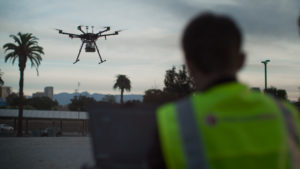
Drone companies like PrecisionHawk have led the industry in the inspection power distribution and transmission infrastructure like lines, towers, transformers and other components of the electrical grid – work that can be dangerous and costly for non-aerial inspectors.
Drone tech has improved conditions for power workers by keeping them off of towers and out of harm’s way while providing detailed data about the health of power assets.
DroneLife recently interviewed PrecisionHawk VP of Product Management and Design Kristen Ellerbe about the state of utility inspection drones.
DL: What solutions does PH offer the utility industry for this issue?
Kristen: PrecisionHawk is helping utility companies collect, process, and analyze thermal imagery to identify overheating parts before they fail and cause outages. Drones and other collection methods are used to capture thermal images of electrical equipment. From there, a model in PrecisionAnalytics reviews the images and detects items of concern on a pole—connection points, insulators, transformers, splices, and more.
Our Data Services team then loads anomaly reports, created with cutting-edge AI algorithms, into the PrecisionAnalytics software interface. In the platform, assets can be filtered down to only those with potential damage. With a reduced number of images to review, utility companies can identify thermal issues and rank them by severity so that they can be pushed to work orders and repaired quickly. PrecisionHawk enables enterprise companies to upload reports and images into the system and pull insights out, with a robust API library to integrate PrecisionAnalytics into their existing workflow.
DL: What benefits are utilities seeing from PrecisionHawk’s drone offering solutions?
Kristen: PrecisionHawk saves utility companies time and money by reducing the noise and narrowing in on hotspots to review. Currently, thermographers must review every single image that comes in. With an average of five images per pole and 30 images per feeder, and a $30 hourly rate for thermographers, this adds up. PrecisionAnalytics, an AI-powered analysis engine, reduces the time spent reviewing images that lack valuable data by identifying potential thermal anomalies. Our model also uses situational awareness to exclude known false negatives like cars and heat spots on background buildings.
DL: How has the utility market responded to PrecisionHawk’s business case in regards to this problem?
Kristen: Utility companies are searching for hot spots and conducting thermal reporting across the nation. The ability to more efficiently review and identify thermal issues is valuable not only from a resource standpoint but also to maintain network uptime. No matter the climate, preventing components from overheating is crucial to avoiding outages.
DL: Going forward, what is PrecisionHawk doing to educate utilities about such problems and solutions?
Kristen: We help leading American utilities identify sources of thermographic data and develop operational models that incorporate the use of robotics and our AI-powered thermographic tagging engine. These operational models emphasize first safety and accuracy, by showing utilities how to institute rigorous standard operating procedures in service of this particular application. We’ve also developed the thermographic reporting based on state operational objectives of our utilities, ensuring they deliver the needed information to make asset management decisions.
Currently, PrecisionHawk works with four of the top 10 utility companies in the world with nearly 50 drone operators in the field.
Jason is a longstanding contributor to DroneLife with an avid interest in all things tech. He focuses on anti-drone technologies and the public safety sector; police, fire, and search and rescue.
Beginning his career as a journalist in 1996, Jason has since written and edited thousands of engaging news articles, blog posts, press releases and online content.
Email Jason
TWITTER:@JasonPReagan
Subscribe to DroneLife here.